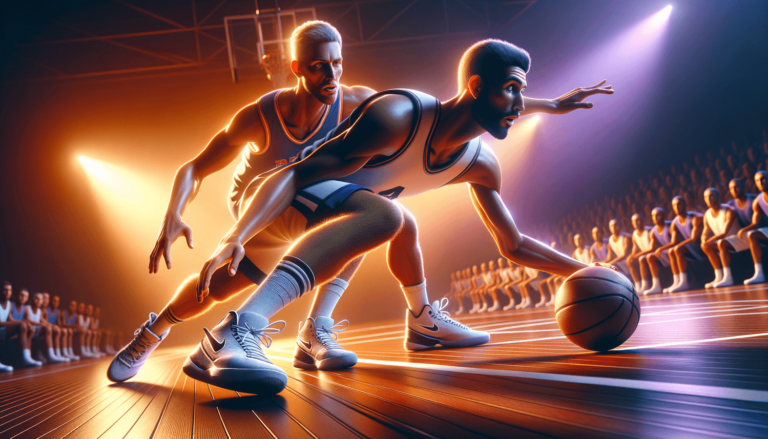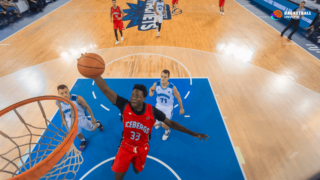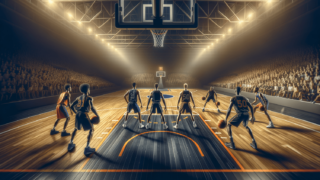
Welcome to the exciting world of basketball, where every move counts, and the game’s beauty comes to life through skillful executions and smart thinking on the court! In this blog post, we’re going to explore a key component of the sport: the baseline drive. Hold onto your hats, because we’re about to break down this thrilling and strategic move, uncovering the ins and outs to help you become a true basketball aficionado. Not only will you impress your friends with your newfound knowledge, but you’ll also gain a deeper understanding of the game you love so much. So, strap in and get ready for takeoff, as we dive into the world of baseline drives in basketball!
What’s a Baseline Drive in Basketball?
A baseline drive in basketball is an offensive move where a player dribbles the ball along the baseline, the boundary line under each hoop, towards the basket. This maneuver aims to outmaneuver defenders, create scoring opportunities, and open passing lanes to teammates in a better position to score.
Mastering the Baseline Drive: An Essential Skill in Basketball
Understanding and utilizing the baseline drive effectively is a crucial component in every basketball player’s skill set. In this comprehensive guide, we’ll discuss various aspects of this essential offensive move and provide tips on how to best execute it on the court. So, let’s dive in and take a closer look at the baseline drive and what makes it a powerful element in the game of basketball.
The Significance of the Baseline Drive
In basketball, the ultimate objective is to outscore your opponents through dynamic and versatile offensive play. The baseline drive is one such effective instrument that helps players create scoring opportunities and challenges the defense in different ways. Below are some key reasons why the baseline drive holds significant importance in basketball.
Exploiting Weaknesses in the Defense
When a player drives along the baseline, they put pressure on the opposing team’s defense, as the defense may fail to adequately cover this area of the court. A well-executed baseline drive can potentially expose a weak or poorly positioned defense, giving the player an opportunity to score or create scoring chances for teammates.
Creating Space for Teammates
A successful baseline drive can also draw additional defenders, leaving other teammates open for a pass or an uncontested shot. By exploiting the created space, players can take advantage of the defense’s collapsed structure and capitalize on available opportunities.
Enhancing Offensive Options
The baseline drive adds another dimension to a team’s offensive arsenal, forcing the defense to remain alert and consider multiple offensive threats. This strategic move can open up the court, allowing for a more versatile and dynamic offense, and keeping the opponent’s defense on its toes.
Executing the Baseline Drive: Techniques and Tips
To successfully implement the baseline drive in basketball, players must master several techniques and follow essential tips. Let’s break down these components, guiding you towards becoming a more dangerous and effective player on the court.
Recognizing the Opportunity
Identifying the right moment to initiate a baseline drive is paramount. When a defender is not in a proper defensive stance or has left space to be exploited, it’s the ideal time for the player to attack the baseline. Additionally, players should look for opportunities when opponents are focused on top-ball movement or are temporarily out of position.
Initiating the Drive
Acceleration is critical in a baseline drive, as it enables the player to beat their defender with speed. To initiate the drive, a player should lower their center of gravity, remain balanced, and forcefully push off their back foot to generate maximum power for a quick first step, driving towards the basket.
Maintaining Control
During the baseline drive, a player must maintain control of the ball, keeping it low and close to their body to prevent turnovers. Utilizing efficient dribbling techniques, such as a power dribble, can help maintain momentum and control throughout the drive.
Avoiding Defenders
While driving along the baseline, players must evade defenders and limit their options to contest the shot or force a turnover. To achieve this, a player can use various moves such as crossover dribble, behind-the-back dribble, or a spin move to sidestep an incoming defender or maintain their momentum towards the basket.
Sealing off the Defender
As a player turns the corner on their baseline drive, it’s important to create separation from the defender, effectively sealing them off. To do so, players should use their body and arm to prevent the defender from recovering and contesting the shot or making a steal attempt. This barrier can create a valuable window of opportunity for the player to pass or take a shot.
Finishing the Play
Upon reaching the basket, a player must successfully finish the play with a high-percentage shot, which can be achieved in several ways:
- Layup: Using a controlled layup allows the player to utilize the backboard for an easier shot, or if the angle permits, go for the reverse layup to shield the ball from any potential shot blockers.
- Floater: Employing a floater shot is ideal when faced with a taller defender or shot blocker. The shot’s high, soft trajectory makes it difficult for defenders to contest.
- Mid-range Jumper: When faced with multiple defensive threats near the basket, a quick pull-up for a mid-range jump shot can be an effective option, allowing for easier shooting mechanics and a high success rate.
Remember, it’s imperative to read and react to the defensive pressure and positioning when choosing the best shot option to finish the baseline drive.
Pivotal Passes
Often during a baseline drive, the player may attract additional defenders, making finishing the play difficult. In such situations, it’s essential to recognize open teammates and deliver a crisp, accurate pass. This can be achieved by using a bounce pass, a chest pass, or even a behind-the-back pass, depending on the player’s court vision and the defenders’ position.
Defending Against the Baseline Drive
As basketball is a game of offense and defense, understanding how to prevent a baseline drive is just as crucial as executing one. Here are some essential defensive strategies that can help mitigate the effectiveness of a baseline drive:
Proper Defensive Positioning
To effectively defend against a baseline drive, a player should adopt a low and balanced stance and avoid being squared up with the offensive player. By angling their feet and body towards the sideline, a defender limits the offensive player’s space to drive the baseline.
Anticipating the Drive
Defenders should keep an eye on the offensive player’s body language and the ball’s positioning. Recognizing a potential baseline drive in advance allows the defender to respond accordingly, redirecting the offensive player away from the baseline or denying them space for a drive.
Help Defense
Teammate support is a vital component of basketball defense. Effective communication and awareness of when to help or switch are crucial when defending against a baseline drive. The help defender’s timely intervention can disrupt the play, forcing the offensive player to pick up their dribble or make an ill-advised pass.
Drills to Improve Baseline Drives and Defense
Practice makes perfect – this old adage holds true for enhancing your baseline drive abilities and defending against them. Implementing specific drills can help players improve their understanding and execution of baseline drives, as well as bolster their defensive skills. Here are some popular drills to incorporate into your training regimen:
One-on-One Baseline Drive Drill
This drill requires one offensive player, one defender, and a coach. The offensive player starts at the wing area, with the defender positioned between the player and the basket. The coach tosses the ball out, and both players race to retrieve it. Once the offensive player has gained possession, they attempt to drive along the baseline and score, while the defender tries to prevent the play. The drill continues with each player switching roles.
Baseline Help Defense Drill
In this drill, two offensive players and two defenders are required. The offensive players are stationed on opposite wings with the defenders guarding them. The drill starts with one offensive player driving towards the baseline while the other offensive player cuts towards the basket. The defender guarding the driver must attempt to stop the baseline drive, while the other defender anticipates the cutter and tries to deny a passing opportunity. The drill continues with players switching roles and repeating the process.
Mikan Drill
Named after basketball legend George Mikan, this drill helps players develop the skills necessary to successfully finish a baseline drive with a layup. Players take turns performing layups on alternating sides of the basket, focusing on proper footwork, utilizing the backboard, and maintaining shooting accuracy.
Applying the Baseline Drive in Competitive Play
With practice and perseverance, using the baseline drive effectively in competitive basketball games is easily attainable. By mastering the techniques and applying the strategies discussed in this guide, players can significantly improve their scoring and playmaking abilities, making them a formidable force on the basketball court. Remember, honing the art of the baseline drive is a continuous process, and incorporating the concept into both individual and team practice sessions will lead to greater success in competitive play.
The Art of Reading and Reacting
An important aspect of executing a successful baseline drive is understanding how to read and react to the opponent’s defensive strategies. Reacting appropriately to the defense’s adjustments can turn an otherwise average baseline drive into an opportunity to outsmart the opposition and increase your team’s chances of success.
Defensive Shifts
Effective defensive teams will continually make adjustments to stifle a baseline drive. They may opt for a help-side defense, traps, or even switch defenders based on your moves. By recognizing these defensive shifts, you can take advantage of mismatches or quickly redirect your drive towards the middle of the court to find an open teammate.
Adapting Your Drive
No two baseline drives are identical, and the most successful players adapt their moves according to the defensive pressure they face. Adapting your drive may involve using various finishing moves or changing your dribble style to protect the ball. Recognizing defensive shifts and reacting accordingly will enable you to stay one step ahead and maintain your offensive edge.
Incorporating Different Finishes
Sporting an extensive finishing repertoire makes it difficult for defenders to predict and stop your baseline drive effectively. Expanding your skill set with a variety of finishing moves can help you convert more opportunities and keep the defense guessing.
Bank Shot
Consider utilizing the bank shot, which bounces the ball off the backboard and into the basket from various angles. By developing solid fundamentals and footwork, you can effectively position yourself for bank shots during baseline drives, making it harder for defenders to contest.
Power Layup
A power layup enables you to finish strong even in the presence of contact. Having this move in your arsenal can be crucial when driving baseline, especially when faced with a physical defender or aggressive help defense.
Finger Roll
The finger roll, a soft and delicate finish, allows skilled players to put just the right amount of touch on the ball to navigate it over the fingertips of defenders. Mastering this move adds a level of finesse to your baseline drive, while increasing your scoring efficiency.
Dissecting Classic Baseline Drive Examples
Studying the game of basketball greats can provide invaluable insights into how to perfect your baseline drive execution. Pay attention to their footwork, timing, and mental approach to the drive, as well as how they read and react to opposing defenses. Some classic examples of successful baseline drives include:
Michael Jordan’s Reverse Layup
One of the signature moves of basketball legend Michael Jordan is his reverse layup during a baseline drive. Jordan’s exceptional athleticism allowed him to elude defenders, finish on the opposite side of the rim, and use the backboard as protection from shot blockers.
Manu Ginobili’s Eurostep
Argentinian basketball star Manu Ginobili popularized the Eurostep move in the NBA. By using a quick and fluid two-step motion, Ginobili was able to cover significant ground while driving baseline, effectively bypassing defenders and finishing with a layup or a smooth underhanded scoop shot.
Allen Iverson’s Deadly Crossover
Former NBA Most Valuable Player Allen Iverson was notorious for his lethal crossover dribble, which he frequently utilized during his baseline drives. With a sudden change of direction and a quick first step, Iverson left his defenders struggling to keep up, allowing him to drive baseline and score with relative ease.
By dissecting and emulating the moves of these successful players, you can improve your own baseline drive and elevate your basketball game. Never stop learning and always be prepared to adapt and refine your techniques, as that’s the key to staying ahead of the competition.
FAQs: Baseline Drive in Basketball
Have more questions about the baseline drive in basketball or how to improve your skills on the court? Check out our frequently asked questions section below. We provide concise answers to common queries related to this essential basketball move.
1. When should I attempt a baseline drive?
Attempt a baseline drive when your defender is not in a proper defensive stance or has left enough space to be exploited. Also, look for opportunities when opponents are overly focused on top-ball movement, leaving the baseline exposed.
2. How do I start a baseline drive?
To initiate a baseline drive, lower your center of gravity for balance and forcefully push off your back foot for maximum power in your first step. Propel yourself towards the baseline while maintaining a tight dribble to protect the ball from defenders.
3. What are the most effective finishing moves for a baseline drive?
Layups, floaters, and mid-range jumpers are effective finishing moves for a baseline drive. Choose the best shot option depending on the defensive pressure, positioning, and potential shot-blocking threats.
4. How can I avoid turnovers during a baseline drive?
Maintain control of the ball by keeping it low and close to your body, utilizing efficient dribbling techniques like the power dribble. Also, use moves such as crossover dribbles, behind-the-back dribbles, or spin moves to evade incoming defenders.
5. How can I improve my baseline drive?
Practice and repetition are essential in improving your baseline drive. Focus on honing your dribbling skills, footwork, acceleration, and various finishing moves. Don’t forget to work on your defensive skills, too, as being a well-rounded player is vital to your success on the court.
6. How do I defend against a baseline drive?
Adopt proper defensive positioning, anticipate the drive, maintain a low and balanced stance, and use help defense when needed. Additionally, communication with teammates is crucial to effectively defend against a baseline drive.
7. What drills can I practice to improve my baseline drive?
The one-on-one baseline drive drill, baseline help defense drill, and Mikan drill are useful basketball drills for improving your baseline drive, finishing moves, and defensive capabilities.
8. Can the baseline drive lead to more passing opportunities?
Yes, baseline drives often lead to additional passing opportunities when defenders collapse to protect the basket, leaving your teammates open for a pass and an uncontested shot.
9. How long does it take to master the baseline drive?
Mastery of the baseline drive depends on individual effort, dedication, and practice. There is no specific timeline, as it varies from player to player. However, consistent practice, analysis, and implementation of the right techniques can expedite the learning process.
10. Can players of all levels benefit from mastering the baseline drive?
Yes, players of all skill levels, from amateurs to professionals, can benefit from mastering the baseline drive, as it adds versatility to their offensive options and enhances their overall skill set.
11. Does height or agility impact the success of the baseline drive?
While taller or more agile players may have a slight advantage, any player can effectively execute a baseline drive with proper technique, control, and speed. Practicing the necessary skills and recognizing optimal opportunities can help players maximize their success with the baseline drive.
12. How can I incorporate the baseline drive into my overall game?
Incorporate the baseline drive into your overall game strategy by practicing it during team drills and scrimmages. Develop a variety of finishing moves and demonstrate an ability to react to defensive adjustments to keep your opponents guessing and off-balance.
13. Are certain playing positions better suited for executing a baseline drive?
Though guards and wings often utilize the baseline drive due to their agility and dribbling skills, any player can effectively execute a baseline drive, provided they have the necessary skill set, technique, and court awareness.
Featured Posts
- No pillar pages found.



